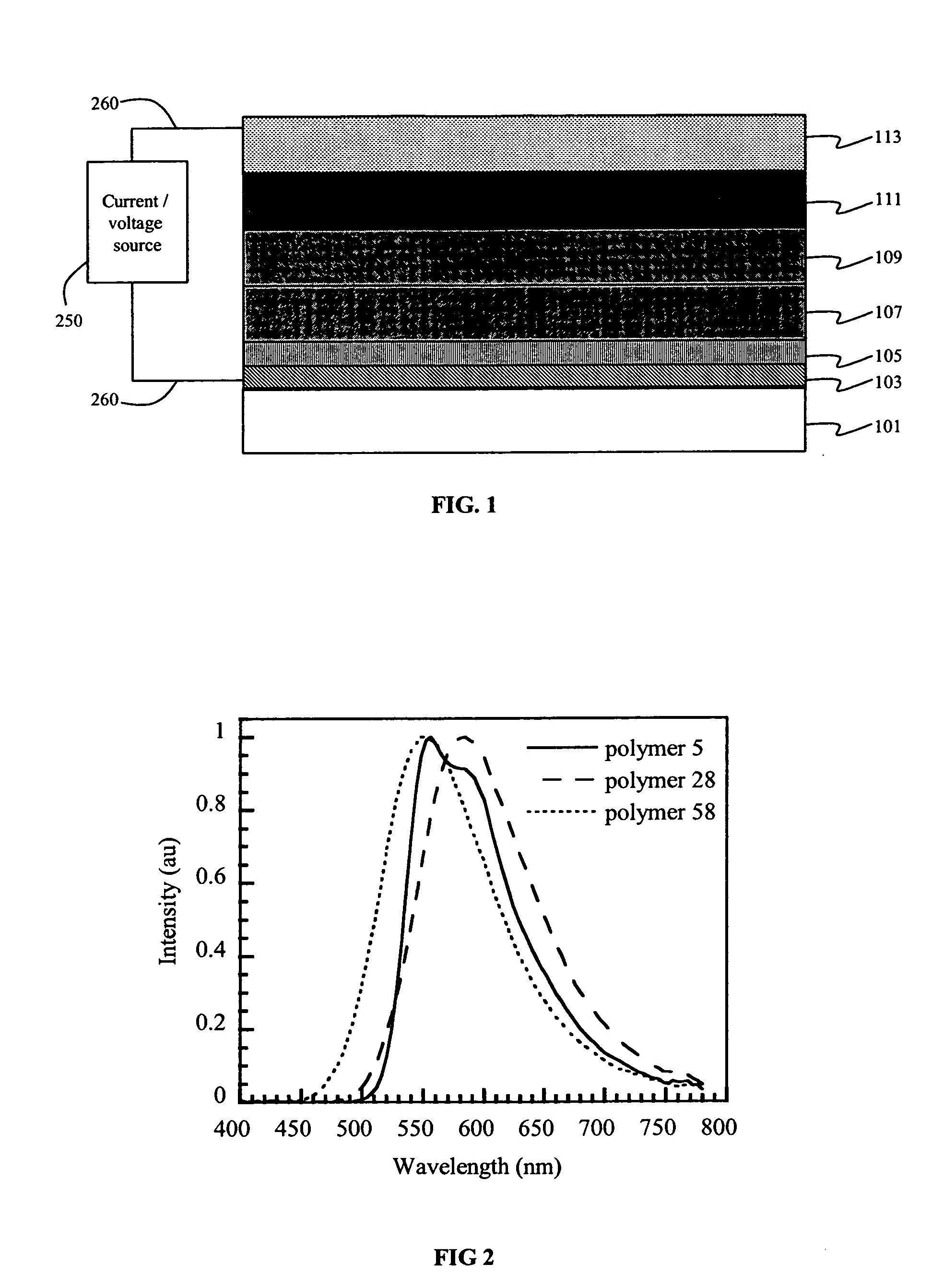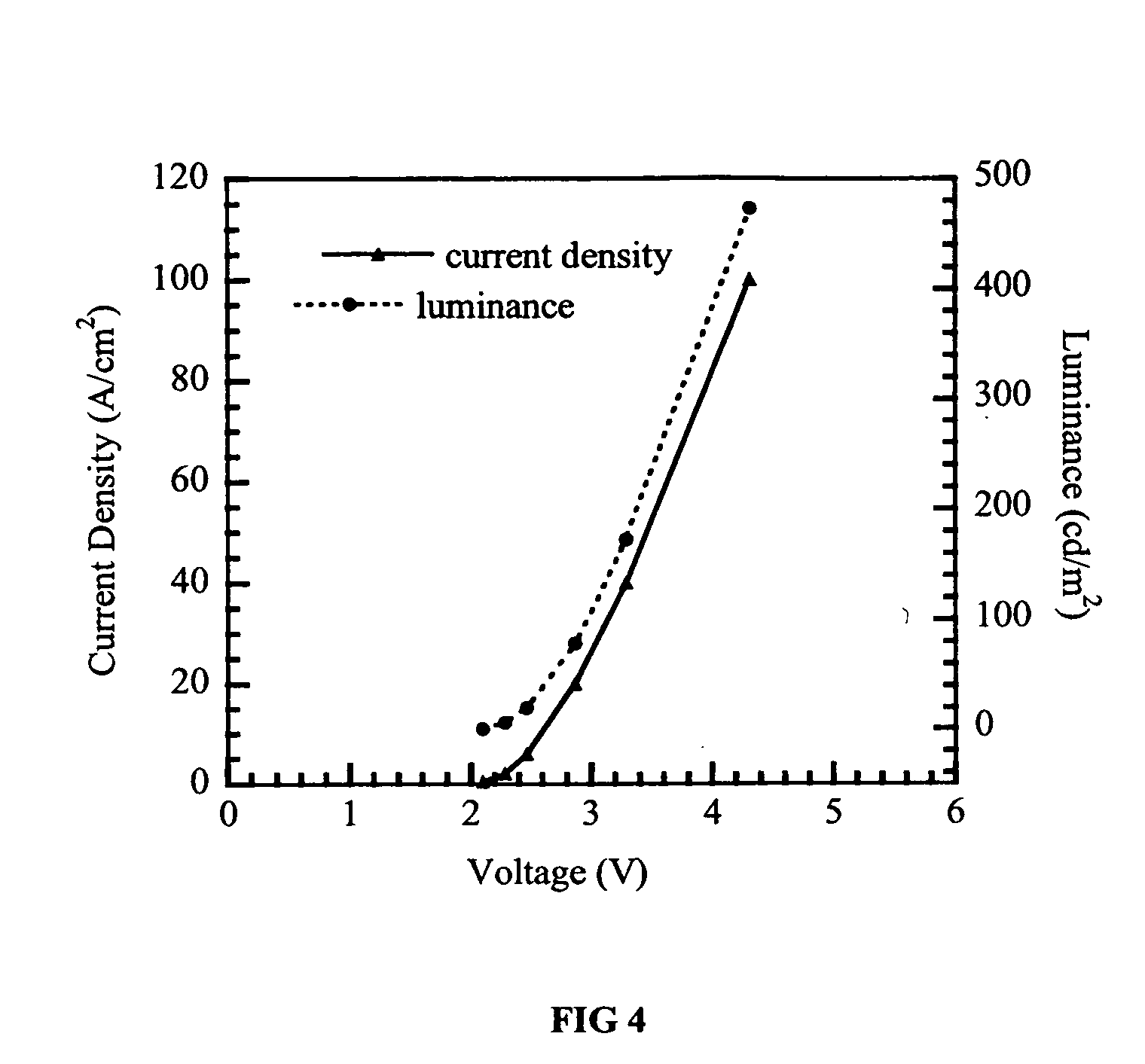Electroluminescent devices having conjugated arylamine polymers
- Summary
- Abstract
- Description
- Claims
- Application Information
AI Technical Summary
Benefits of technology
Problems solved by technology
Method used
Image
Examples
example 1
Synthesis of dimethyl 2-bromo-terephthalate (compound 1)
[0366] Dimethyl 2-amino-terephthalate (10.0 g, 0.048 mol) was dissolved in 60 mL of concentrated HBr solution (50% in water) at 60° C. The red solution was cooled in an ice-bath and a microcrystalline suspension was obtained. To this suspension was added 2.5 M NaNO2 solution (21 mL, 0.052 mol) under vigorous stirring. The resulting yellow diazonium compound was transferred to a cooled additional funnel (−5° C.) and added to a cooled solution of CuBr (9.1 g, 0.064 mol) in 25 mL of concentrated HBr solution. A defoaming agent n-butanol was used to prevent excessive foaming. After the addition was complete, the reaction was heated to 70° C. until no further nitrogen evolved. The reaction was cooled, and was extracted with ether. The organic phase was washed with water and dried over MgSO4. The crude product was obtained as gray black solid and was purified by recryllization from heptane to give 6.6 g of pure product as white soli...
example 2
Synthesis of dimethyl 2-phenylamino-terephthalate (compound 2)
[0367] Dimethyl 2-bromo-terephthalate (10.0 g, 0.037 mol), aniline (17.0 g, 0.18 mol), potassium phosphate (11.7 g, 0.055 mol), and Pd2(dba)3 (0.67 g, 0.73 mmol) were mixed in 100 mL of anhydrous toluene. The mixture was bubbled with nitrogen for 10 min. and tri t-butyl phosphine (0.12 g, 0.58 mmol) was added. The reaction was heated to reflux overnight. The reaction was cooled down and extracted with ether. The combined organic phase was dried over MgSO4 and solvent was removed. The crude product was obtained as dark brown oil. The crude product was purified by column on silica gel using 10 / 90 methylene chloride / heptane as an eluent to obtain yellow solid which was further recrystallized in heptane to give 6.0 g of pure product as orange crystals at 58% yield. 1H NMR (CDCl3) δ (ppm): 3.87 (s, 3 H), 3.93 (s, 3 H), 7.24-7.36 (m, 6 H), 7.91-8.03 (m, 2 H), 9.50 (s, br, 1H). 13C NMR (CDCl3) δ (ppm): 52.06, 52.34, 114.83, 115...
example 3
Synthesis of 4-diphenylamino-iodobenzene (compound 3)
[0368] Diphenyl amine (21.0 g, 0.12 mol), 1,4-diiodobenzene (49.1 g, 0.15 mol), potassium carbonate (51.4 g, 0.37 mol), copper bronze (15.6 g, 0.25 mol), and crown-18-6 (3.1 g, 15 wt % to diphenyl amine) were mixed in 200 mL of o-dichlorobenzene and the reaction was heated to reflux overnight. The reaction was cooled down and the solid was filtered off and washed with methylene chloride. The filtrate was concentrated and cooled in dry ice. 1,4-Diiodobenzene crashed out upon cooling and was filtered off. The process was repeated until most of 1,4-diiodobenzene was removed from crude product. The crude product was then purified by column chromatography on silica gel using heptane as an eluent to give 20.1 g of pure product as white solid at 44% yield. 1H NMR (CDCl3) δ (ppm): 6.82 (d, J=8.8 Hz, 2 H), 7.00-7.27 (m, 10 H), 7.48 (d, J=8.8 Hz). 13C NMR (CDCl3) δ (ppm): 122.67, 123.30, 124.13, 124.52, 125.27, 129.17, 129.34, 138.01, 147....
PUM
 Login to View More
Login to View More Abstract
Description
Claims
Application Information
 Login to View More
Login to View More - Generate Ideas
- Intellectual Property
- Life Sciences
- Materials
- Tech Scout
- Unparalleled Data Quality
- Higher Quality Content
- 60% Fewer Hallucinations
Browse by: Latest US Patents, China's latest patents, Technical Efficacy Thesaurus, Application Domain, Technology Topic, Popular Technical Reports.
© 2025 PatSnap. All rights reserved.Legal|Privacy policy|Modern Slavery Act Transparency Statement|Sitemap|About US| Contact US: help@patsnap.com



